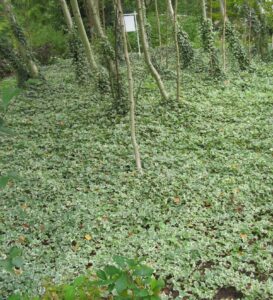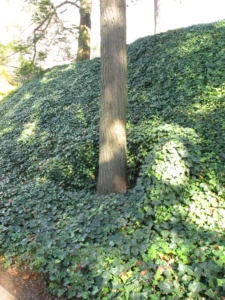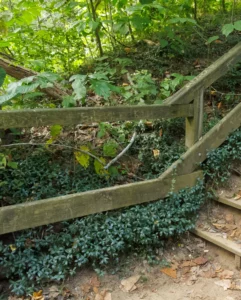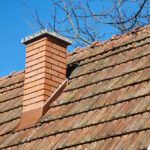Select Ground Covers for your Landscape Carefully
Thanks to the University of Maryland/Maryland Grows this informative article on how to select ground covers.
Ground cover
Plants that are used as ground cover can provide great services throughout the landscape as they can fill in areas that might otherwise be left bare or covered in mulch. Ground covers can be used to help reduce maintenance chores by preserving moisture and preventing weeds.
If you are looking for a ground cover plant, consider adding a native ground cover. Non-native ground covers and vines can be the plants of nightmares, as the characteristics that we like about them (aggressive, can take over weeds, need little care once established, etc.) are often the characteristics that make them terrible offenders when they escape into natural areas. A great field guide on this exact topic is Plant Invaders of Mid-Atlantic Natural Areas.
Prime planting season is now!
Since it’s prime planting season in Maryland, here I highlight three herbaceous plants that are often used as ground covers that can quickly take over. For a more detailed list of some of the other ground covers that are concerning, check out this webpage, Invasive Vines and Groundcovers.


English ivy (Hedera helix) is sometimes just called “ivy” or “European ivy”, which reiterates the point that it is not a plant that is native to the United States. This evergreen, vining plant is one that you should be aware of as it can take over areas through the spread of seeds and through underground stems. It thrives in shade, is drought tolerant, and once established, it creates a thick, dense mat of foliage that can outcompete many perennials. It’s even been reported that it can damage homes/walls where it grows up and even penetrates the bark on living trees and strangles them. A study done in February of 2021 found that there are at least 5,000 trees in Takoma park could be lost because of English ivy. English ivy also serves as a reservoir for bacterial leaf scorch, a disease in maples, oaks, and elms.
Furthermore, get more information on English ivy, visit these webpages from the University of Maryland Extension: English Ivy and Invasives in Your Woodland.


Invasive species
Periwinkle is a common plant that many people will recognize by its attractive shiny green leaves and purple-white flowers. There are actually two types, Vinca minor and Vinca major, unfortunately, both are considered invasive species and spread quickly vegetatively by root pieces (digging) and rooting at tips and nodes that contact the ground.
The third plant is bishop’s weed or goutweed (Aegopodium podagraria). Once established, this plant easily gets out of hand and is very difficult to remove. It is on the Maryland Department of Agriculture’s list of plants considered for regulation. Joyce Browning with the University of Maryland Extension in Harford County recently posted a video about bishop’s weed.
It can be overwhelming when considering adding plants in troubled areas. A great resource for ideas is the University of Maryland Extension webpage about Lawn Alternatives.
Mitigate negative effects of invasive plants
Remember that you can help mitigate the negative effects of invasive plants on local ecosystems. Simply do not add them to your landscape. However, if you already have some of these plants, you can also manage them correctly by keeping them contained in certain areas. You will be eliminating their spread into natural areas. Never place yard trimmings into natural areas. Remove the seeds before they can be spread by wind, rain, and/or animals. As you are adding plants to your landscape, please check out these great resources for non-invasive plant suggestions:
Landscaping with Native Plants- Maryland Native Plant Society
Keystone Plants by Ecoregion- National Wildlife Federation
Resources on invasive plant identification:
Plant Invaders of the Mid-Atlantic Natural Areas (PDF)
Do Not Sell! Ornamental Invasive Plants to Avoid with Climate Change (PDF)
In conclusion, everyone can help in the fight against invasive plants! Check the University of Maryland Extension website for an Introduction to Invasive Plants in Maryland. Get more information on how to reduce invasive plants. The absolute best way is to just never plant or introduce them into your landscape.
By Ashley Bodkins, Senior Agent Associate and Master Gardener Coordinator, Garrett County, Maryland. Read more posts by Ashley.
If you are looking to buy or sell your home (with or without a garden), contact Gigi today. Oh by the way, I’m never too busy for any of your referrals!






Recent Comments